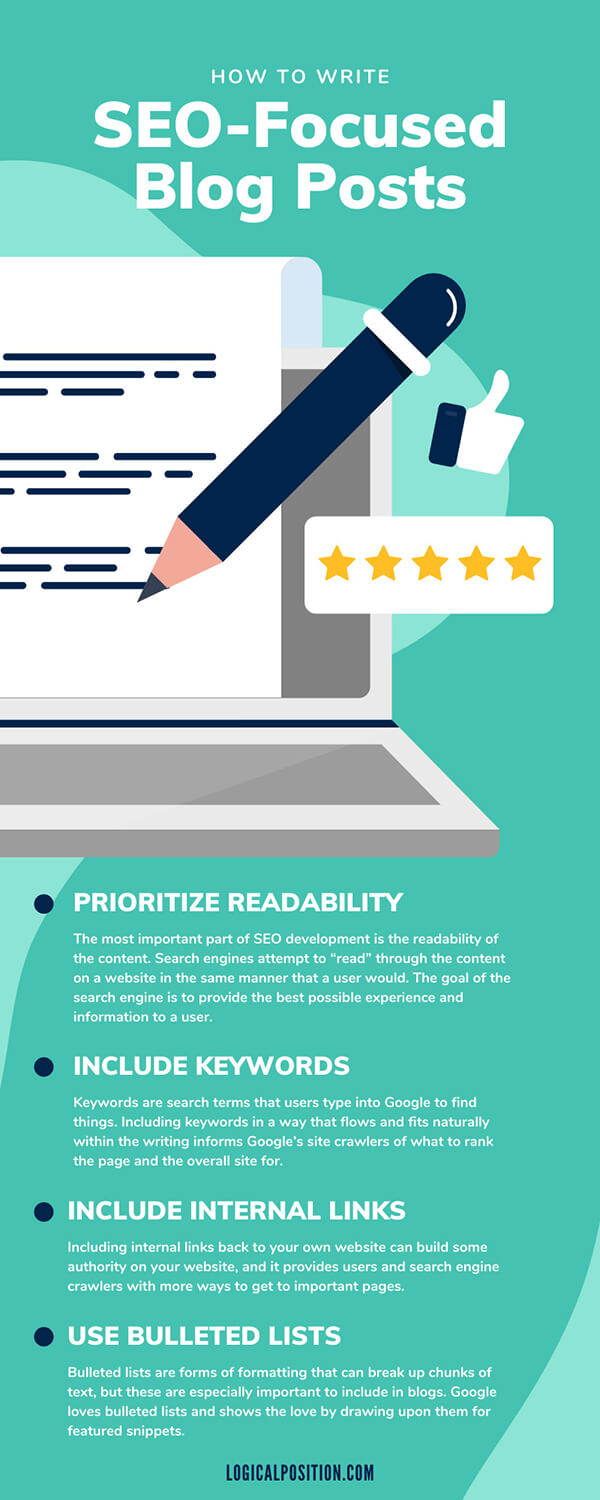Search engine optimization, or SEO, is a way to steadily build trust with search engines and web users. It increases a company’s online visibility while boosting users’ confidence in the legitimacy of the brand. A copious number of websites are all competing for the coveted real estate on the first few pages of the Google search results for certain key terms.
One of the pillars of building SEO is blogging. Google uses the content on a website to determine what it’s about and what it should rank for. The most reliable way to steadily build SEO over time is to consistently update the website with fresh, high-quality, relevant content. Blogging is the best way to accomplish this. If a company want to improve its SEO, it must learn how to write SEO-focused blog posts.
Prioritize Readability
The most important part of SEO development is the readability of the content. Search engines attempt to “read” through the content on a website in the same manner that a user would. The goal of the search engine is to provide the best possible experience and information to a user.
Ensure the content in your blog posts makes sense and is easy to read. The content must flow and include consistency in word choices so that the average user can read it with ease. Unique content is important—don’t plagiarize, as Google flags duplicate content across the web. Your site can get into major trouble for this. Write your own unique content that’s relevant to your business.
Make it a point to include formatting to break up chunks of text. Readers are less likely to muddle through long paragraphs and wordy sentences. Utilize H2s and H3s to break the information into sections, and consider other ways to segment the text. Here are a few options for breaking up chunks of text:
- Bulleted lists
- Numbered lists
- Different-size headings
- “Pro tips” or small blurb sections
- Short paragraphs
Keep in mind when writing content for your blog that most people will see it on a mobile device with a small screen, making long chunks of text even more overbearing on the display. Keep paragraphs short and simple to improve your bounce rate and keep things digestible.
Include Keywords
Keywords are search terms that users type into Google to find things. Do some keyword research to discover which words and phrases are the most important to rank for based on search volume and your industry. Aim for keywords that your customers or potential customers use and that relate cohesively to your business.
Including keywords in a way that flows and fits naturally within the writing informs Google’s site crawlers of what to rank the page and the overall site for. Check out a few helpful hints when it comes to keywords:
- Use a primary keyword, which should appear in the title of the blog, twice within the content.
- Use a targeted keyword twice in the content.
- Avoid keyword stuffing—all keywords should fit naturally in the blog.
- Use keywords that make sense with the content. (For instance, don’t use a keyword about lip gloss when the blog is about eyeshadow colors.)
Include Internal Links
Including internal links back to your own website can build some authority on your website, and it provides users and search engine crawlers with more ways to get to important pages. When you’re writing a blog for your website, a good rule of thumb is to include a minimum of one and a maximum of three links to different pages on your website. These links could be a previous blog post, a landing page, or anything else to which you want to drive attention and traffic.
Internal links provide more ways for users and search engines to get to your vital pages. Fitting internal links and keywords together is a great way to get in these two essential items.
Stay Cautious with External Links
Avoid putting external links, or links to another website, into your blog posts or anywhere on your site. Adding links to other sites draws from the link equity, or “link juice,” a page has. Keep that link equity for your own site by skipping the external link inclusions.
Use Bulleted Lists
Bulleted lists are forms of formatting that can break up chunks of text, but these are especially important to include in blogs. Google loves bulleted lists and shows the love by drawing upon them for featured snippets. A featured snippet puts your blog page at the top of the search results without taking up the first organic result slot. It’s also called “position zero.”
Bulleted lists are digestible and easy to read, and they help the end user and increase your chances for securing the spot for a featured snippet. They break up long chunks of text while making important points stand out to readers. Securing the featured snippet for a key term for your site makes your website more visible and shows that it is a trustworthy authority on the subject.

Overall, Keep the End User in Mind
The most important part about developing SEO-focused content on your website through the use of a blog is to design the blog for users. Search engines look for user-focused websites and a top user experience. Blogs need to flow and look visually appealing to human eyes to catch the attention of search engines.
SEO is complicated, and writing consistent, high-quality blog posts with the seamless use of keywords is no easy feat. Consider hiring a professional SEO agency such as Logical Position. We have a history with Google and SEO. We know the best practices, how to increase organic rankings, and how to secure featured snippets with white-hat, or “Google-approved,” practices. We can cater to any industry and create quality content that Google looks for. Contact us today for a free consultation on our SEO services.
Working with the right SEO agency—one that caters to your industry and needs while listening and aiding in the development of goals—can be groundbreaking. Your business can reach its full potential organically through upkeep and intentional blogging. Logical Position is here to help with our team of talented content writers, expert editors, and professional graphic designers.




